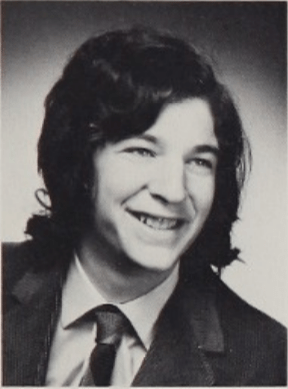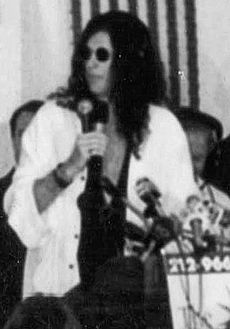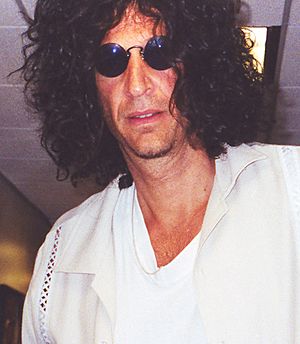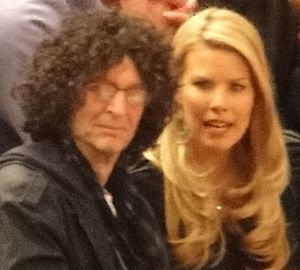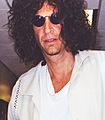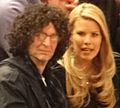Howard Stern facts for kids
Quick facts for kids
Howard Stern
|
|
|---|---|
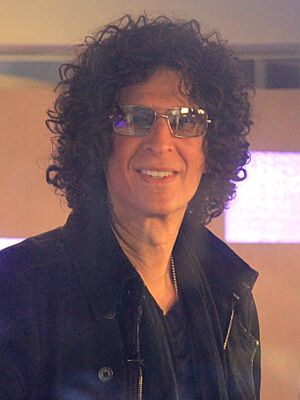
Stern in 2012
|
|
| Born |
Howard Allan Stern
January 12, 1954 New York City, U.S.
|
| Education | Boston University (BA) |
| Occupation |
|
| Years active | 1975–present |
| Political party | Libertarian |
| Spouse(s) |
Alison Berns
(m. 1978; div. 2001)Beth Ostrosky
(m. 2008) |
| Children | 3 |
Howard Allan Stern (born January 12, 1954) is an American broadcaster and media personality. He is widely known for his radio show, The Howard Stern Show. This show became very popular when it was broadcast across the country on regular radio from 1986 to 2005. Since 2006, he has been broadcasting on SiriusXM, a satellite radio service.
Stern started his first radio jobs while he was a student at Boston University. From 1976 to 1982, he developed his unique on-air style by working morning shows at various radio stations. These included WRNW in Briarcliff Manor, New York; WCCC in Hartford, Connecticut; WWWW in Detroit, Michigan; and WWDC in Washington, D.C. He then worked afternoon shows at WNBC in New York City from 1982 until 1985. In 1985, he began a 20-year period at WXRK in New York City. His morning show started being broadcast to many stations in 1986. At its most popular, it was heard in 60 different areas and had 20 million listeners.
In recent years, Stern has also shown his photography in magazines like Hamptons and WHIRL. From 2012 to 2015, he was a judge on the popular TV show America's Got Talent.
Stern has received many awards in the entertainment industry. He won Billboard magazine's Nationally Syndicated Air Personality of the Year award eight times in a row. He was also the first person to have the number one morning radio show in both New York City and Los Angeles at the same time. He became one of the highest-paid radio personalities after signing a five-year deal with Sirius in 2004, which was worth $500 million.
Since 1992, Stern has called himself the "King of All Media" because of his success beyond radio. He hosted and produced many late-night television shows, pay-per-view events, and home videos. Two of his books, ... Parts (1993) and Miss America (1995), both became number one bestsellers on The New York Times list and sold over one million copies each. ... Parts was even made into a biographical comedy movie in 1997. Stern and his radio show team played themselves in the film. It was the top movie at the American box office during its first week and earned $41.2 million in the U.S. Stern also performed on the movie's soundtrack, which reached number one on the Billboard 200 chart and sold one million copies. Stern's third book, Howard Stern Comes Again, was released in 2019.
Contents
- Early Life and School
- Career in Radio and Television
- Early Radio Jobs (1976–1981)
- Moving to Washington, D.C. and New York City (1981–1985)
- Moving to WXRK and Early TV Projects (1985–1993)
- Books and Political Candidacy (1993–1994)
- More Books and Films (1995–1997)
- Television and Film Projects (1998–2004)
- Moving to Satellite Radio (2004–2010)
- Recent Years: SiriusXM and America's Got Talent (2010–Present)
- FCC Guidelines and Fines
- Personal Life
- Film and TV Appearances
- Music Albums
- Images for kids
- See also
Early Life and School
Howard Allan Stern was born on January 12, 1954, in the Jackson Heights neighborhood of Queens in New York City. He was the second child of Ben (1923–2022) and Ray (born Schiffman) Stern (born 1927). Stern's parents are Jewish, and their families came from Poland and Austria-Hungary.
Ray worked as an office clerk before becoming a homemaker. Later, she worked as an inhalation therapist. Ben served in the U.S. Army during a war. He later worked as a radio engineer and co-owned a recording studio in Manhattan. At this studio, cartoons and commercials were made. Stern described his older sister Ellen as "very quiet" and "the complete opposite" of himself.
In 1955, his family moved to Roosevelt, New York, on Long Island. Stern attended Washington-Rose Elementary School and then Roosevelt Junior-Senior High School. He also went to Hebrew school, where he was given the name Tzvi. As a child, Stern took piano lessons for five years. He also enjoyed marionettes and used them to entertain his friends. He formed a band called Electric Comicbook with two school friends, where he played vocals and keyboards. From age nine until his second year of university, Stern spent his summers at Camp Wel-Met, a youth camp in Narrowsburg, New York. He worked there as a camper, in the kitchen, and as a counselor. He remembers his time there as "the greatest experience."
Stern wanted to work in radio from the age of five. He didn't listen to much radio when he was young, but he mentioned talk show hosts Bob Grant and Brad Crandall as early inspirations. His father set up a microphone, tape machine, and turntable in their basement. Stern used these to record his pretend radio shows, creating different characters and making fake prank calls, skits, and commercials. He often visited his father's recording studio and saw "some of the great voice guys" working there. This included Don Adams and Larry Storch doing voices for Tennessee Tuxedo and His Tales. This made him want to be on the air and "do a show," rather than just play music.
In the late 1960s, Roosevelt became a mostly Black neighborhood. Stern remembered that only "a handful of white kids" remained in his school, and he experienced bullying from some Black students. In June 1969, his family moved to nearby Rockville Centre. Stern, who was fifteen, transferred to South Side High School, where he became "a total introvert." He graduated from the school in 1972. His yearbook shows that his only student activity was being a member of the Key Club.
In 1972, Stern chose to study communications at Boston University instead of attending Elmira College. Because his high school grades were average, he spent his first two years in the College of Basic Studies. In his second year, he started working at the campus radio station WTBU. There, he played music, read the news, and hosted interview programs. He later co-hosted a weekly comedy show called The King Schmaltz Bagel Hour with three other students. This show was stopped during its first broadcast because of a controversial sketch.
In 1974, he was accepted into the university's School of Public Communications. In July 1975, he studied for a diploma at the Radio Engineering Institute of Electronics in Fredericksburg, Virginia. This earned him a first-class radio-telephone operator license, which was required for all radio broadcasters at the time by the Federal Communications Commission. With this license, Stern got his first professional radio job at WNTN in Newton, Massachusetts. From August to December 1975, he worked air shifts, read news, and did production work. For the next five months, he taught basic electronics to students preparing for their own FCC exams.
In May 1976, Stern graduated with high honors, achieving a 3.8-grade point average. His main subject was broadcasting and film, and his minor was English and speech. He has since funded a scholarship at the university.
Career in Radio and Television
Early Radio Jobs (1976–1981)
After graduating, Stern found a job working evenings at WRNW, a progressive rock station in Briarcliff Manor, New York. He wasn't sure if he was good enough for a career in radio. He briefly worked in advertising but soon returned to radio. With encouragement from his mother and girlfriend, Stern contacted WRNW again and took on holiday cover shifts in late 1976. The station's director was impressed and hired Stern full-time for a four-hour midday shift, six days a week, for $96 a week. After several months, Stern became the station's production director. In November 1977, he became the program director, earning $250 a week. To save money, Stern rented a room in a monastery in Armonk, New York.
In 1979, Stern saw an advertisement for a "wild, fun morning guy" at WCCC, a rock station in Hartford, Connecticut. He created a demo tape with more daring segments and was hired for the same salary but with a much busier schedule. He worked four hours on air, then four more hours voicing and producing commercials. On Saturdays, after a six-hour show, he did three more hours of production. He also served as the station's public affairs director and hosted a Sunday morning talk show. He preferred the talk show because it allowed him to "take the average guy and dissect what he does." During the 1979 energy crisis, Stern encouraged listeners to boycott Shell Oil Company for two days, which gained media attention. It was at WCCC that Stern first met Fred Norris, who became his writer and producer in 1981. Stern left WCCC in early 1980 after being denied a small raise.
Stern then found a job as a morning host at WWWW, a struggling rock station in Detroit, Michigan. He started on April 21, 1980. He tried new ways to make his show better and be more open on air. His efforts were successful, and he won a Billboard Award for Album-Oriented Rock Personality of the Year. Despite this success, WWWW's ratings continued to drop. In January 1981, the station changed its music style overnight from rock to country, which surprised Stern. He stayed for two more weeks before leaving.
Moving to Washington, D.C. and New York City (1981–1985)
Stern's next job was hosting mornings at WWDC, a rock station in Washington, D.C.. He started on March 2, 1981. He spent several weeks planning a new show, aiming for greater success. He wanted to "kill my competition" and "say whatever the heck I was going to say." He looked for a co-host with a good sense of humor to discuss news and current events. The station paired Stern with Robin Quivers, a former nurse in the Air Force and news reporter. Quivers accepted the job without meeting Stern, thinking she would just read the news. However, it became much more. Despite some issues with management over content, which led to a seven-second delay to censor certain moments, Stern continued to develop his show. He added Norris as his writer and producer. By January 1982, Stern had the second highest-rated morning show in the city.
Impressed by his rising ratings, WWDC offered Stern a contract extension. However, Stern wanted a longer deal. At the same time, he was offered a five-year deal worth $1 million to work afternoons at WNBC in New York City. Stern signed with WNBC in March 1982. His relationship with WWDC management worsened, and he often criticized them and other DJs on air. On June 25, 1982, Stern was fired from WWDC. By the end of his time there, Stern had more than tripled his ratings. The Washingtonian magazine named him the city's best disc jockey.
Stern began his afternoon show at WNBC on August 30, 1982. He was closely watched and told to avoid discussions about sensitive topics. In his first month, he was suspended for a sketch. The station then hired an attorney to operate a seven-second delay if Stern said anything potentially offensive. This job later went to program director Kevin Metheny, whom Stern often joked about. While at WNBC, Stern also began a long-running friendly rivalry with the station's morning host Don Imus.
In 1984, Stern hired Don Buchwald as his agent, who helped him get a new three-year contract with WNBC in early 1985. His popularity grew despite the station's rules. On May 21, 1984, he appeared on Late Night with David Letterman for the first time and was featured in People magazine, which increased his national fame. In May 1985, Stern achieved the highest ratings at WNBC in four years for the afternoon audience. However, Stern and Quivers were fired on September 30, 1985, for what WNBC called "conceptual differences" about the show.
Moving to WXRK and Early TV Projects (1985–1993)
After being fired from WNBC, Stern stayed in touch with his audience by performing live stage shows at clubs. He chose to stay in New York to "kick NBC's butt." In October 1985, Stern announced he had signed a five-year contract with Infinity Broadcasting worth about $500,000. He would host afternoon shows on their rock music station WXRK starting November 18. WNBC allowed Stern to leave his contract. Determined to beat Imus and WNBC in the ratings, Stern moved to the morning slot in February 1986. His show began to be broadcast to other stations on August 18 of that year. In New York, Stern had the highest-rated morning radio program between 1994 and 2001. During Stern's twenty years at WXRK, his show was broadcast in 60 areas across North America and reached a peak audience of 20 million listeners.
Stern's first step into television was when the Fox network looked for a replacement for The Late Show. After talks in late 1986, Stern agreed to make five one-hour pilot episodes for an estimated $400,000. However, Fox decided not to pick up the show. One Fox executive described the pilots as "poorly produced," "in poor taste," and "boring." Stern then hosted his first pay-per-view event in February 1988.
In October 1989, fans quickly bought out tickets for Howard Stern's U.S. Open Sores at Nassau Coliseum. This was a live event featuring a tennis match between Stern and his producer Gary Dell'Abate. Stern later released this event for home video.
In 1990, Rolling Stone magazine predicted Stern was "on the fast track to multimedia stardom." He signed a new five-year deal with Infinity Broadcasting to continue his radio show, which New York Magazine estimated was worth over $10 million. In July 1990, Stern became the host of the Saturday night variety television show The Howard Stern Show on WWOR-TV, featuring himself and his radio show staff. The show continued to air and was broadcast to other stations in 1991, reaching a peak of 65 areas. In New York, the show often beat Saturday Night Live in ratings when their airtimes overlapped. Stern ended the program after 69 episodes in 1992.
By this time, the radio show had received several fines from the Federal Communications Commission (FCC) for content they considered inappropriate. As part of his protest against the FCC's actions, Stern released a music album of censored radio segments called Crucified by the FCC in early 1991.
Stern's growing popularity in 1992 led him to first use his self-proclaimed title "King of All Media." This was initially a playful jab at Michael Jackson, who was called "King of Pop." In October 1992, Stern became the first person to have the number one morning radio show in both New York and Los Angeles at the same time. In November 1992, Stern returned to Saturday night television as the host of The Howard Stern "Interview", a weekly celebrity interview series on the E! network, which ended in 1993. Stern also appeared at the 1992 MTV Video Music Awards as Fartman, a fictional superhero.
Books and Political Candidacy (1993–1994)
After a film project was put on hold, Stern's agent began talking with book publishers. In early 1993, Stern signed a deal with Simon & Schuster worth about $1 million to write his first book, ... Parts. He spent the summer writing it with a collaborator and editor, calling it "the most challenging thing I have ever done in my career." When it was released on October 7, 1993, ... Parts was an instant success. The first 225,000 copies sold out within hours. In five days, it became the fastest-selling book in Simon & Schuster's history. Over one million copies were sold after two weeks. ... Parts reached number one on The New York Times Best-Seller list and stayed there for 20 weeks. Stern held book signings across the country, some lasting as long as seven hours. The first one in New York City was attended by an estimated ten thousand people.
In its twentieth anniversary issue in 1993, Radio & Records named Stern "the most influential air personality of the past two decades." In February 1994, Stern was featured on the cover of Rolling Stone magazine for the first of three times. That year, Billboard magazine added a new award category, Nationally Syndicated Air Personality of the Year, which Stern won every year from 1994 to 2002. In late 1993, Stern encouraged his listeners to elect Christine Todd Whitman as Governor of New Jersey after she called into his radio show. In March 1995, after she won the election, Whitman named a highway rest stop after Stern in exchange for his support.
Stern held his second pay-per-view special, The Miss Howard Stern New Year's Eve Pageant, on December 31, 1993. The show was about a fake beauty pageant with celebrity judges. An estimated 400,000 households bought the show, earning $16 million. The New York Post called it "The most disgusting two hours in the history of television." The show was released for home video in early 1994.
During his radio show on March 22, 1994, Stern announced he would run for Governor of New York under the Libertarian Party ticket. He planned to bring back the death penalty, remove highway tolls to improve traffic, and limit road work to night hours. Stern said that once these three goals were met, he would resign and let his lieutenant governor take over. At the party's convention on April 23, Stern won the nomination. To get his name on the final ballot, Stern had to provide his home address and a financial disclosure form. Stern tried to avoid stating his income, but a judge denied his request. Stern withdrew his candidacy two days later, saying he didn't want to reveal his personal finances. In the gubernatorial election on November 8, Mario Cuomo was defeated by George Pataki, whom Stern supported. In August 1995, Pataki signed a bill that limited construction on state roads to night hours in New York City and Long Island, which was named the "Howard Stern Bill" in honor of Stern's idea. Stern has since changed his mind and is now "firmly opposed" to the death penalty.
In June 1994, Stern started the Howard Stern Production Company for "original film and television production." In the same month, the E! network began showing daily highlights from Stern's radio show using cameras in the studio. Howard Stern ran for eleven years, with the last original episode airing on July 8, 2005.
More Books and Films (1995–1997)
On April 3, 1995, three days after the shooting of singer Selena, Stern's comments about her death caused controversy among his listeners in Texas and some Mexican American communities. He criticized her music, and sound effects of gunfire were played. After three days of media reaction and boycott threats, Stern responded with a statement in Spanish, saying his comments were meant as satire and not to hurt anyone. The next day, a judge in Texas issued an arrest warrant for Stern for disorderly conduct, which carried a potential fine if he entered the state. Stern was never arrested.
In 1995, Stern signed a deal with ReganBooks worth about $3 million to write his second book, Miss America. Stern wrote about various topics, including his experiences on the Internet, a private meeting with Michael Jackson, his struggles with back pain and obsessive–compulsive disorder, and his run for Governor of New York. After its release on November 7, 1995, Miss America sold 33,000 copies at Barnes & Noble stores, setting a new one-day record for the chain, and 120,000 in its first week. It reached number one on The New York Times Best-Seller list and stayed there for 16 weeks. According to Publishers Weekly, 1.39 million copies were sold in 1995 alone, making it the year's third best-selling book. Like with ... Parts, Stern's book signings attracted thousands of people.
In February 1996, production began on a biographical comedy film adaptation of ... Parts for Paramount Pictures. Stern had final approval of the script and had rejected many earlier versions. After producer Ivan Reitman joined the project, Stern agreed to a script. Filming began in May 1996 with director Betty Thomas and lasted four months. Stern, Quivers, and Norris played themselves in the movie. The crew traveled to the film set after each radio show and worked on weekends. Stern did a lot of publicity to promote the film, including many television appearances and magazine interviews, to reach people who didn't listen to his radio show. ... Parts premiered on February 27, 1997. The film was widely released on March 7, 1997. It was the top movie at the U.S. box office during its opening weekend, earning $14.6 million, and made a total of $41.2 million in the U.S. In 1998, Stern received a Blockbuster Entertainment Award for Favorite Male Newcomer. The soundtrack, Private Parts: The Album, sold 178,000 copies in its first week and reached number one on the Billboard 200 chart in March 1997. Three months after its release, the album was certified platinum for selling one million copies. Stern also sings on "Tortured Man", a song he recorded with The Dust Brothers.
Television and Film Projects (1998–2004)
In April 1998, Stern announced his return to Saturday night television after signing a deal with CBS. His show, The Howard Stern Radio Show, was an hour-long program made of recorded highlights from the radio show, plus extra material not seen on his E! show. After its debut on August 22, 1998, on 79 stations, the show began to lose stations because local broadcasters were concerned about the content. By June 1999, the number of stations carrying the show had dropped to fifty-five. After three seasons, the final show aired on November 17, 2001.
In the first Celebrity 100 list by Forbes magazine in March 1999, Stern was ranked at number 27 with an estimated $20 million earned that year. While his CBS television show was running, Stern also worked as an executive producer through his production company for several television and film projects. In September 1999, the UPN network announced the production of Doomsday, an animated science-fiction comedy television series. Stern was to produce the series and voice the family's dog, but the show never aired. Stern's most successful executive production was Son of the Beach, a comedy show that made fun of Baywatch. It ran from March 2000 to October 2002 on FX. The show was not continued for a fourth season.
On December 16, 2000, Stern's last live radio show of the year, he announced a new five-year contract with Infinity Broadcasting. Forbes estimated his new earnings were between $17 million and $20 million a year. Stern spoke at The Concert for New York City in October 2001. In November 2001, Stern's production company began developing a weekly television comedy show called Kane for CBS. The project was canceled before filming. In late 2002, Stern acquired the rights to the comedy films Rock 'n' Roll High School (1979) and Porky's (1982) with Arclight Films. He wanted to use a remake of Rock 'n' Roll High School to help an unknown band become famous. Under the deal, Stern was an executive producer and could put "Howard Stern Presents" in the titles.
In March 2003, Stern filed a $100-million lawsuit against ABC and the producers of its reality television series Are You Hot?. He claimed its idea was copied from a segment on his radio show where his staff and guests would evaluate contestants. A settlement was reached five months later. In August 2004, the cable channel Spike ordered thirteen episodes of Howard Stern: The High School Years, an animated series about Stern's childhood that he was to executive produce. By late 2005, scripts and some test animation were done, but the project was soon stopped. Stern explained that the series could have been made cheaply, but the quality he wanted would have cost over $1 million per episode. Actor Michael Cera was cast as the main voice.
Moving to Satellite Radio (2004–2010)
The controversy around the Super Bowl XXXVIII halftime show on February 1, 2004, led to stricter government rules on radio and television content. This caused station managers to control content more tightly, which made Stern feel creatively "dead." After some companies were fined for content the FCC considered inappropriate, Stern announced on October 6, 2004, that he had signed a five-year deal with Sirius Satellite Radio. Sirius is a subscription-based satellite radio service that is not subject to the FCC's broadcast rules. This move, starting in 2006, was seen as the beginning of "a new era of radio." Stern's final live show on regular radio aired on December 16, 2005.
Stern's first contract with Sirius was worth $500 million, with a budget of $100 million a year for production, staff, and programming. In 2005, he created two channels, Howard 100 and Howard 101, which launched in September. He also formed Howard 100 News, a team of reporters hired to cover daily stories about his radio show and those connected to it. Stern ended his eleven-year relationship with E! and made a deal with the iN DEMAND network to launch Howard Stern On Demand, a video-on-demand service, to show uncensored recordings of his Sirius radio show. This service was relaunched as HowardTV in March 2006 and continued until December 2013. A new, modern studio and office space were built for the show at Sirius' headquarters in New York City. On January 9, 2006, the day of his first broadcast on Sirius, Stern and his agent received 34.3 million shares of Sirius stock, worth $218 million, for reaching subscriber goals. In January 2007, another subscriber goal was met, and Stern received 22 million shares of stock worth $82.9 million. In 2006, Time magazine included Stern in its Time 100 list, and he also ranked seventh on Forbes' Celebrity 100 list in June 2006. When Sirius merged with XM Satellite Radio in 2008 to form SiriusXM, the company paid Stern $25 million as part of his contract. In 2006, Stern filed a trademark for the name "King of All Media."
On February 28, 2006, CBS Radio filed a lawsuit against Stern, his agent, and Sirius. They claimed that Stern used CBS broadcast time to promote Sirius during his last fourteen months on regular radio. Stern held a press conference before the lawsuit was filed, saying it was a "personal vendetta" against him by CBS president Leslie Moonves. A settlement was reached out of court in May 2006, where Sirius paid CBS $2 million for the rights to Stern's radio shows since 1985.
Recent Years: SiriusXM and America's Got Talent (2010–Present)
In December 2010, Stern renewed his contract with SiriusXM to continue his radio show for another five years. His new deal allowed him to work a reduced schedule of three live radio shows each week instead of four. On March 22, 2011, Stern and his agent filed a lawsuit against SiriusXM for $300 million, claiming they were not paid additional annual bonuses despite Stern meeting subscriber growth targets. On April 17, 2012, a judge disagreed with their lawsuit and dismissed it. They filed an appeal, but it was rejected.
By mid-2011, Stern spent less time playing chess and started photography. He took photos for Hamptons magazine in July. He continued to take photos throughout the year, including for WHIRL magazine and the North Shore Animal League. He also started his photography company, Conlon Road Photography, named after the road he lived on as a child.
Later in 2011, Stern announced he would return to network television as a judge on America's Got Talent for its seventh season, replacing Piers Morgan. He had the show move to Radio City Music Hall in New York City to fit his radio show schedule. Stern then reappeared on the Forbes Celebrity 100 list at No. 26. He continued as a judge on the show for the eighth, ninth, and tenth seasons. Stern left the show at the end of its tenth season in September 2015 to focus more on his radio show.
Stern was inducted into the National Radio Hall of Fame in 2012. He has openly criticized the organization.
In August 2013, Stern and Simon Cowell shared first place on Forbes' list of America's highest-paid television personalities, earning $95 million between June 2012 and 2013. They tied for first place again the following year with the same amount. In 2015, Forbes named Stern the world's highest-paid media personality and the fifth highest-earning celebrity worldwide, at $95 million.
In February 2015, Whalerock Industries announced a partnership with Stern to create a future digital "media hub" service, which might include both free and subscription-based content. On December 15, Stern announced a new deal with SiriusXM to continue his radio show for another five years. The agreement also gives Sirius the rights to his radio and video archives for an upcoming on-demand streaming application until 2027.
In April 2018, Stern inducted Bon Jovi into the Rock and Roll Hall of Fame.
In March 2019, Stern announced his third book for Simon and Schuster titled Howard Stern Comes Again. It was released on May 14, 2019.
In May 2020, Stern spoke about his past actions on his show, admitting that "The stuff I did was crazy." He said he has since changed his show, crediting years of psychotherapy for his personal growth.
In December 2020, Stern renewed his contract with SiriusXM, agreeing to produce his show for five more years.
In June 2022, Stern stated his interest in running for President of the United States in 2024, if Donald Trump becomes the Republican nominee again. In April 2024, he completed a one-on-one interview with President Joe Biden.
FCC Guidelines and Fines
Between 1990 and 2004, the Federal Communications Commission (FCC) issued fines totaling $2.5 million to the owners of radio stations that broadcast The Howard Stern Show. These fines were for content the FCC considered inappropriate for public airwaves.
Stern believed that the Bush administration was responsible for the increased FCC fines and scrutiny of radio broadcasts in 2004. This followed a controversy during the Super Bowl XXXVIII halftime show that February. Because of this, Stern began openly supporting John Kerry's presidential campaign that year and encouraged listeners to vote against Bush.
Personal Life
Family and Relationships
Stern met his first wife, Alison Berns, at Boston University through a friend. He included Berns in a student film he made. Stern wrote, "Within a week after our relationship began, I knew I was going to marry her." They married in Brookline, Massachusetts, on June 4, 1978, when both were 24 years old. They have three daughters: Emily Beth (born 1983), Debra Jennifer (born 1986), and Ashley Jade (born 1993). In October 1999, they decided to separate. Stern said, "I was totally focused on work. I took work as the most important thing." He moved from their home in Old Westbury, New York, to an apartment in Manhattan. The marriage ended in 2001 with a friendly divorce. Stern has since bought a home in Southampton, New York on Long Island.
In 2000, he began dating model and television host Beth Ostrosky. He announced their engagement on his radio show on February 14, 2007. They married at Le Cirque restaurant in New York City on October 3, 2008. The ceremony was led by Mark Consuelos. In 2017, Stern bought a home in Palm Beach, Florida, for $52 million.
Other Activities
In the early 1970s, Stern's parents began to practice Transcendental Meditation and encouraged him to learn. Stern credits this technique with helping him quit smoking, achieve his goals in radio, overcome obsessive–compulsive disorder, and help his mother with depression. As of 1997, he continued to practice it. Stern has interviewed Maharishi Mahesh Yogi, the founder of the technique, and thanked him for helping his mother.
Stern revealed his struggle with obsessive–compulsive disorder in Miss America. His condition started while he was at university and continued into his radio career.
In 2012, Stern said he had adopted a pescetarian diet, which means he eats fish but no other meat. In 2019, Stern shared that he had a health scare two years earlier when a growth was found on one of his kidneys. It turned out to be a harmless cyst.
Stern is a long-time supporter and fundraiser for North Shore Animal League America. Stern and Ostrosky have been fostering cats in their Long Island home since 2014. About 200 cats come through their home every year.
Film and TV Appearances
Movies
| Year | Title | Role | Notes |
|---|---|---|---|
| 1986 | Ryder, P.I. | Ben Wah, a news reporter | |
| 1997 | ... Parts | Himself |
|
Home Videos
| Year | Title |
|---|---|
| 1989 | Howard Stern's U.S. Open Sores |
| 1994 | Howard Stern's New Year's Rotten Eve 1994 |
Television Shows
| Year | Title | Channel/Notes |
|---|---|---|
| 1987 | The Howard Stern Show | Fox, five test pilots that never aired |
| 1990–1992 | The Howard Stern Show | WWOR-TV and affiliates |
| 1992–1993 | The Howard Stern "Interview" | E! |
| 1994–2005 | Howard Stern | E! |
| 1998–2001 | The Howard Stern Radio Show | CBS affiliates |
| 2005–2013 |
|
in DEMAND digital cable |
Music Albums
| Year | Album | Label | Notes |
|---|---|---|---|
| 1991 | Crucified by the FCC | Infinity Broadcasting | |
| 1997 | ... Parts: The Album | Warner Bros. | Reached No. 1 on the Billboard 200 chart, certified Platinum |
Images for kids
See also
 In Spanish: Howard Stern para niños
In Spanish: Howard Stern para niños


